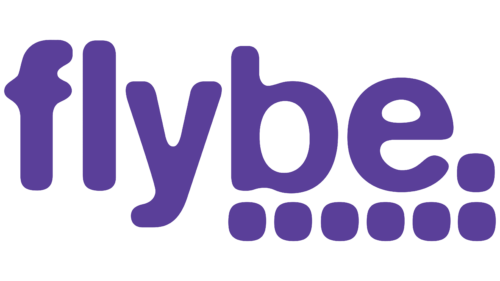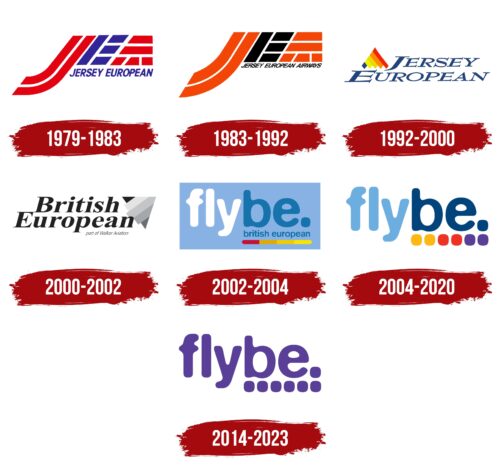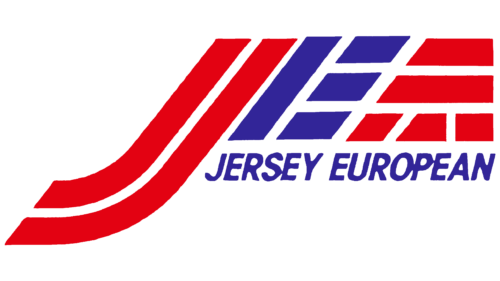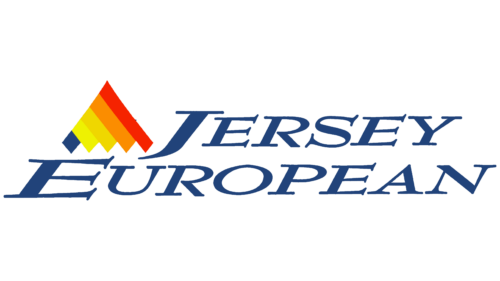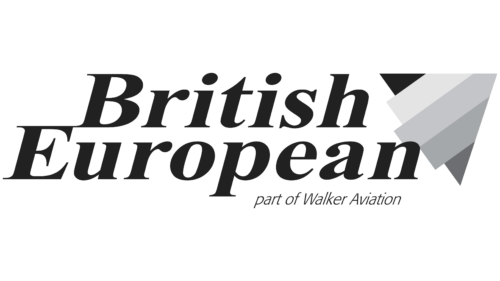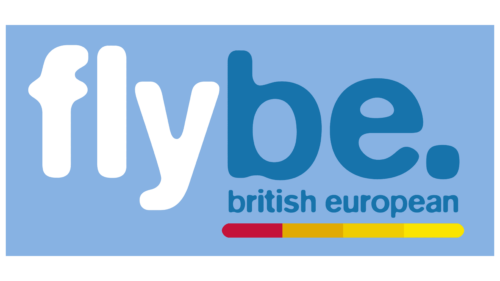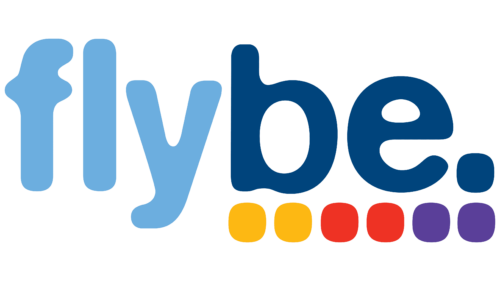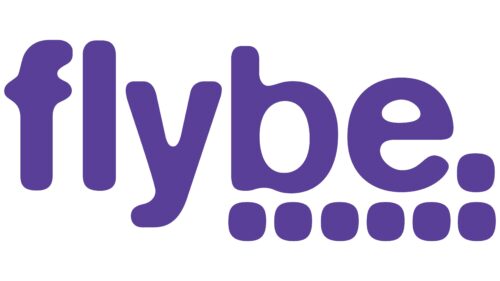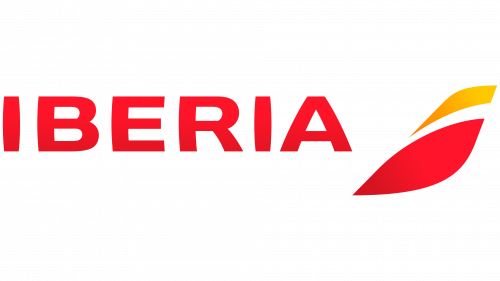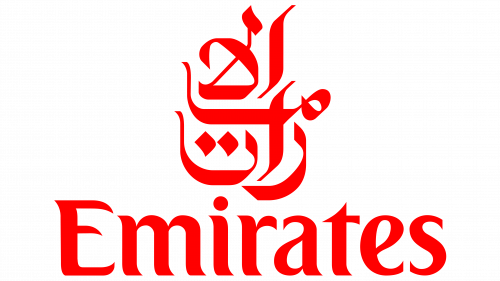The Flybe logo represents the airline’s commitment to accessible, enjoyable air travel. It conveys the philosophy “to fly is to be,” highlighting their focus on enhancing the passenger experience. Their slogan, “fly better,” reinforces this commitment, which speaks to their aim of continuous improvement and customer satisfaction. The design merges elements that evoke flight and aspiration, aligning with their dedication to serving travelers effectively.
Flybe: Brand overview
Founded in 1979 as Jersey European Airways, the airline quickly gained recognition for its reliability and customer focus. Over time, Flybe transformed and rebranded to British European Airways, eventually adopting its iconic name.
Flybe’s rebranding ushered in a new era of success and growth. The airline’s distinctive purple coloration adorned a diverse fleet of aircraft, including fuel-efficient Bombardier Dash 8 Q400s and versatile Embraer E-Jets, allowing it to serve shorter and longer European routes.
Strategic partnerships with renowned airlines such as British Airways, Air France, and Emirates have greatly enhanced Flybe’s connectivity and customer experience.
However, Flybe has faced numerous challenges throughout its existence. Rising fuel prices, increased competition, and the economic downturn of 2008 affected the airline’s profitability. Despite its best efforts, the airline needed additional funding to sustain its operations. This heartbreaking turnaround occurred on January 28, 2023, marking the end of Flybe’s presence in the airline industry.
Meaning and History
What is Flybe?
It is a British regional airline operating domestic and short-haul international flights across the UK and Europe. It is known for connecting small airports and providing regional connectivity between different parts of the UK and neighboring countries. The airline provides affordable and convenient travel options, catering to business travelers and regional passengers. The fleet consists mainly of turboprop aircraft suitable for short routes and small airports.
1979 – 1983
From 1979 to 1983, the company, later known as Flybe, was originally named Jersey European Airways. This name reflected the airline’s strong connection to the island of Jersey, a territory of the British Crown and one of the company’s popular flight destinations.
The logo for Jersey European Airways featured capital letters styled to resemble airport runways. This design effectively communicated the company’s key attributes: precision in flight execution, speed in service, logical structure in route planning, and technical excellence in aircraft maintenance. Each element of the logo was carefully thought out to emphasize the professionalism and reliability of the carrier.
The logo’s red and blue colors, shades of the British flag, clearly indicated the company’s British origin. This was important for international recognition and highlighted the company’s affiliation with British airlines. The name “Jersey European” was prominently displayed at the bottom of the logo, serving as a reminder of the company’s geographic focus and its roots connected to the island of Jersey.
1983 – 1992
The change in ownership and strategic merger with Spacegrand Aviation marked a new phase in the company’s history, necessitating a comprehensive rebranding. One of the most noticeable changes was updating the logo’s color palette. The brand’s visual aspect underwent significant changes: the traditional blue and red colors were replaced by orange and black. These colors were deliberately chosen to represent new beginnings and the company’s development strategies symbolically.
The orange color in the logo symbolizes energy, optimism, and customer focus, highlighting the company’s commitment to innovation and improving user experience. Black adds a sense of solidity and professionalism, which is associated with reliability and stability in service provision. The combination of these colors hints at the cooperation between the two companies, emphasizing their interaction and joint efforts to achieve common goals.
1992 – 2000
The new logo, designed by the well-known British design firm Wolff Olins, features a triangular sign composed of five runway lines. This unique design evokes the image of a Boeing or airplane ascending, effectively conveying the company’s ambitions and aspirations in the aviation industry.
The sign’s symbolism subtly alludes to the island of Jersey, a primary flight destination for the airline. This design element emphasizes the strategic importance of this route for the company and reflects the distinctiveness and beauty of the island. Within the symbol, one can see the sun and sky, which suggest the warmth and hospitality of the local resort, inviting passengers to experience its unique offerings.
The triangular logo resembles a mountain, symbolizing the airline’s growth and development. This design element signifies the airline’s continuous expansion of flight destinations and efforts to enhance service quality. Every part of this symbol demonstrates a dedication to enhancement and innovation, from technical details to improved travel times.
2000 – 2002
In 2000, Jersey European Airways (JEA) underwent significant changes, including a name change to British European. This decision was reflected in the updated emblem and symbolized a strategic reorientation of the brand. As the company expanded its operations beyond regional transport, Jersey was no longer the sole or primary destination. The company’s focus shifted towards a broader European audience and major airports in England, as reflected in the new name emphasizing this regional and geographical reach.
The triangular icon previously used in the logo was moved to the top right corner, symbolizing an airplane ascending into the sky. This change is intended to convey the company’s dynamics, growth, and continuous development. The stripes and the image of the airplane’s nose pointing upward enhance the visual perception of movement forward and upward, metaphorically reflecting the company’s aspirations for new heights and successes.
The logo’s color palette was changed: shades of gray and black became dominant. These colors are associated with power and metal, symbolizing reliability and durability in aviation structures. However, despite their association with sturdiness, these colors are perceived as somewhat sad in the context of passenger transport, presenting a challenge in portraying the brand as friendly and welcoming.
The subtle inscription at the bottom of the logo emphasized the carrier’s affiliation with the Walker brand, clarifying the ownership link and reinforcing the company’s corporate identity within a broad business structure.
2002 – 2004
In 2002, the airline decided to change its name, which influenced a new image and the design of its logo. The new name was placed against a blue rectangle that symbolizes the sky, an element inherently linked to aviation and flight. The graphic division of the name into “Fly” and “be” visually supports a play on words that reflects the company’s philosophy: “to fly is to be” or “to exist to fly.” This stylization offers insight into the company’s mission to make flights accessible and meaningful for everyone.
Another interpretation of “be” is seen as a shorthand for “better,” adding additional meaning to the name — “fly better.” This phrase becomes a motto and a call to enhance the quality and service the company aims to provide to its clients.
The logo’s color scheme plays a key role in conveying corporate values. White symbolizes airy lightness, aligning with the company’s budget carrier position since 2002. Blue expresses professionalism and reliability, emphasizing the company’s serious approach to its operations. Rainbow shades, transitioning from red to yellow, are represented as a single stripe on the logo, symbolizing dynamic acceleration before takeoff — a metaphor for continuous development and striving for progress.
This color palette highlights the friendliness, high-quality service, and pleasure of flying that the company guarantees to its passengers.
2004 – 2020
In 2004, designers updated the corporate logo to make it more appealing and aligned with contemporary trends. As a result, the logo became lighter and more airy, achieved by removing the background fill and using lighter shades. The “Fly” element was colored light blue, symbolizing calm and reliability, while “be” was rendered in a rich blue, reflecting the corporate style and professionalism.
The multicolored squares with rounded corners on the logo are not merely decorative; they serve a specific function. Each color represents different service classes on board the aircraft, helping passengers understand the company’s offerings. For instance, the purple square indicates the company’s commitment to fulfilling its client obligations, implying that passengers can expect compensation during a flight delay. The colors of the squares indicate various flight destinations, allowing passengers to easily identify the region of their flight.
2014 – 2023
The “flybe” logo uses bold, slightly blurry letters with rounded edges, creating a soft, approachable look. Seven large dots in the lower right corner form an incomplete frame around the text. All elements are in a unified shade of purple.
The rounded letters and slight blur indicate movement and fluidity, matching the air travel theme. The seven dots symbolize different destinations or connections, suggesting a wide network. The use of purple adds sophistication, making the logo memorable.
The bold, rounded “flybe” lettering emphasizes comfort and ease, which is important for a pleasant travel experience. The slight blur enhances the impression of gentle movement, like flying through the air.
The seven dots, forming an incomplete frame, suggest growth and potential expansion. Each dot represents a connection, highlighting the airline’s wide reach. The arrangement adds a dynamic feel to the logo, enhancing the sense of movement.
Purple is a distinctive, elegant color associated with luxury and reliability, aligning with the airline’s brand. This choice ensures the logo stands out while maintaining a refined look.
